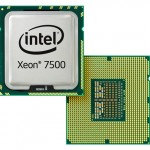The continuous shrinking of transistor size has pushed the limits of how many transistors can be placed on a single die (currently in the millions). In consequence, to utilize the increased amount of transistors, the CPU or “the core” has been replicated multiple times on the same die. Todays CPUs contain multiple cores with each core having fast L1 caches and sharing either a larger L2 or L3 cache, the bus interface, and the external die connections. For example, an Intel Xeon 7500 can support 8 sockets each with 8 cores for a total of 64 cores. Physical machines now commonly use multiple processors, but even in a multi-core processor, each core is treated as a seperate CPU. What this means is that even a multi-core CPU is taking advantage of symmetrical multiprocessing (SMP).
When dealing with physical servers, multiple CPU’s will always aid in processing speed. However, when dealing with the virtual world, don’t assume the same is true. If your running VMWare ESX, whenever the virtual machine (VM) needs the CPU, the VMkernel can send the load to any CPU, so a single CPU virtual machine can get benefits similar to SMP. If you have a licence to SMP, you can assign multiple processors to a virtual machine, but beware that this may not produce desired results. When dealing with multiple processors, the virtual machine will force co-scheduling of physical processors. In this case, when one processor is scheduled, the other ones are as well. This can take resources away from other VMs. Further, all processes may lose the processor time before task completion if a process on one virtual CPU is waiting too long for another process on a different virtual CPU. At this point all benefits of using multiple CPUs are lost.
So, in the virtual world, it is indeed a bit counter-intuitive when you think that dedicating more CPUs to a VM could possibly hurt performance. I’ve actually had the misfortune of seeing this in action and it can be a painfully maddening experience.
Symmetrical Multiprocessing in the Physical and Virtual World
This entry was posted in Intel, Processors/CPUs, Technology, Virtualization and Cloud Computing and tagged CPU, ESX, Intel, multiple cores, Quad Core Intel Xeon E7500, SMP, symmetrical multiprocessing, virtual machine, virtualization, VM, VMkernel, vmware, VMWare ESX, Xeon. Bookmark the permalink.




 Twitter
Twitter LinkedIn
LinkedIn Youtube
Youtube RSS
RSS